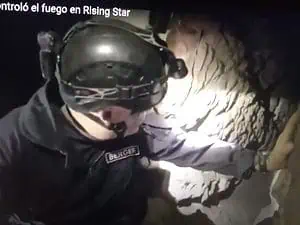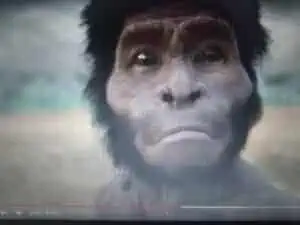Homo naledi paper by Berger likely on DNA discovery
 Lee Berger is a world-renowned evolutionary biology professor at the University of Witwatersrand in Johannesburg, South African. He is also the discover of both Australopithecus sediba and Homo naledi. Prof. Berger has been hinting for months of major announcements to come on Homo naledi.
Lee Berger is a world-renowned evolutionary biology professor at the University of Witwatersrand in Johannesburg, South African. He is also the discover of both Australopithecus sediba and Homo naledi. Prof. Berger has been hinting for months of major announcements to come on Homo naledi.
Dr. Berger serves as the Phillip Tobias Chair of the Evolutionary Anthropology Department at the University of Witwatersrand. (See our article by co-editor Martha Christina of South Africa, Dec. 2022, “Phillip Tobias, a retrospective on the amazing life of one of South Africa’s greatest fossil hunters.” Berger is also designated as a Worldwide Explorer by National Geographic. He is widely regarded as one of the most accomplished living paleo-anthropologists. He has authored and co-authored over 100 academic papers. (See Google Scholar).
From his Bio, Britannica:
American-born South African paleoanthropologist known for the discovery of the fossil skeletons of Australopithecus sediba, a primitive hominin species that some paleontologists believe is the most plausible link between the australopithecines (genus Australopithecus) and humans (genus Homo).
In 2013 and 2014 Berger and colleagues excavated skeletal remains from a deep recess in the Rising Star cave system near the Swartkrans World Heritage Site in South Africa. The remains totaled more than 1,500 fossil specimens belonging to a new species that he and his team named H. naledi.
In early December 2022, Dr. Berger gave a presentation/press conference at Carnegie Science Center in Washington DC. Often clad in Indiana Jones like garb, Berger has always had a flare for the dramatic. As we noted in our article about the announcement:
 like the great paleo-anthropologist Louis Leakey before him, Berger has received criticism throughout the years, for being overly dramatic and even speculative of Hominin phylogenetic (tree of human origins) positioning.
like the great paleo-anthropologist Louis Leakey before him, Berger has received criticism throughout the years, for being overly dramatic and even speculative of Hominin phylogenetic (tree of human origins) positioning.
At Carnegie he announced that he and his team had found hard evidence of Homo naledi’s use of fire.
From Subspecieist, Dec. 2,
Lee Berger’s stunning announcement: Evidence found of Homo naledi fire use in Rising Star cave
Finally in the chamber with one companion (who appears to be Steven Tucker), Berger explored the area. He looked up. On the roof of the chamber, were soot particles, indications of fire use.
The entire roof of the chamber where we’ve spent the last 7 years working is burnt and blackened.
Berger describes his next moments as “serendipitous.”
I then climbed out of the chamber and almost died. Literally. Took me an hour and seven minutes to get out of that chamber. Really.
“How could homo naledi deal in the dark” asks Lee Berger. Inside the chamber he realized the “roof” had blackened areas with soot particles indicating an astounding use of fire. Later his team found burnt animal bones in another chamber. “We clearly had been missing things…I don’t think they were living there, I think they were using the spaces…
Berger held the limelight for days after the stunning announcement. There was some light criticism, mainly that he should have released his findings in a published paper for peer review, other than holding a presentation/press conference. But mainly the announcement was greeted with praise and astonishment.
Throughout press interviews at the time, Berger coyly teased other coming discoveries. He even went so far to state that the discovery of fire use might be the least astonishing of 3 more discoveries yet to be announced.
From a YouTube interview by History with Kayleigh, Jan. 18,
What It’s Like In The Dinaledi Chamber? Interview Lee Berger
 Kayleigh: You have been teasing the people with discoveries, bigger than the discovery of fire used by Homo naledi. Can I ask you to tease the viewers a bit more. Or, should we all wait til you are ready to announce this all yourself?
Kayleigh: You have been teasing the people with discoveries, bigger than the discovery of fire used by Homo naledi. Can I ask you to tease the viewers a bit more. Or, should we all wait til you are ready to announce this all yourself?
Berger: So, umm, I’m in London right now. That’s where I’m doing this video from. I’m on my way to Denmark, on Saturday morning. If anyone in this field who does a little Googling can understand what happens in Copenhagen, and why we’re working there.
Berger is almost certainly referring to the discovery of DNA in Homo naledi fossils. The Max Planck Center in Denmark that he is referring too, is affiliated with the Max Planck Center in Leipzig, Germany where Nobel Prize winner Svante Pääbo, discoverer of Neanderthal and Denisovan DNA, heads the Genetics Research department.
Berger continuing: So, uh, watch the molecular space. That’s fairly obvious. We’ve been on the hunt for that. Homo naledi is an ideal candidate, but not only that space. Watch other spaces in the hominin record that umm… Obviously, molecular discoveries are going to be a big deal.
Homo naledi brain size is 560cc comparable to a Chimpanzee at 465cc
Such a finding could prove highly controversial. UCLA geneticists Sriram Sankararaman and Arun Durvasula published a paper in January 2020, announcing the finding of up to 19% archaic ghost species DNA in modern Africans. Many have speculated that the ghost is likely Homo naledi or perhaps a sister species such as (African) Homo heidelbergensis or (undefined) Florisbad man.
Kayleigh, April 2022:
 The average [Homo naledi] male brain size is 560 cubic centimeters and for the females it was an average of 465 cubic centimeters. This is just slightly larger for instance, than the brain size of Chimpanzees.
The average [Homo naledi] male brain size is 560 cubic centimeters and for the females it was an average of 465 cubic centimeters. This is just slightly larger for instance, than the brain size of Chimpanzees.
So the combination of archaic Australopithecine features and later Homo species features makes Homo naledi truly unique in the human evolutionary timeline… they are an enigma in the evolutionary timeline, their morphology is an absolute mosaic of a puzzle to solve…
Now, Tweet from Berger, January 21:
So, our paper has been submitted and under review in a premier journal. It’s Science Magazine + 6 months. There has been communications saying “it’s the referees.” It’s a major paper holding up dozens of papers. What would you do? I’m tempted to go open. Is it broken?
Note – Berger is saying that the paper has been in their possession for 6 months, idling with no action. This could indicate that it is the long-awaited paper on the discovery of fire. And that the other papers being held up include the paper on DNA findings. Further, “go open” refers to self-publishing.
And a stunning reversal, 24 hours later, Berger Tweeted:
And a miracle has happened in relation to this tweet. We received the reviews today… onwards.



It’s true that Berger has a touch of Barnum in him and he seems to somewhat enjoy sticking his finger in the eye of the paleo establishment.
But it’s also true that it looks like he has just cause. Berger has by far made more specimen contributions than any man in history. His lower-performing colleagues seem to loathe him for it.
When academic resistance is based on ego and personality rather than the science we all suffer.
I still don’t see how H. Naledi used fire.
I still don’t understand why they had to wait until he lost enough weight to get through that narrow passage, I mean I have a diamond blade on my chop saw that could widen that narrow passage space in short amount of time.
Something just doesn’t seem right about this “discovery.”
To accept the use of fire by a hominid like naledi certainly requires an unexpected paradigm shift. In that sense, it may be judging his criticizing peers too harshly to attribute resistance to his conclusions merely to academic career turfing and petty jealousy.
But here’s the thing: Berger has been in the region, grinding professionally, for over 30 years. He says prima facie evidence of hearth is all over the place, not just smoke on the ceiling. This is not the kind of thing that is ambiguous, char is pretty straightforward and he can’t gaslight that to his peers. If he’s blowing sunshine up the wazoo over this, it taints what is irrefutably already one of the most incredible hominid finds of all time. Where’s the advantage for him to misrepresent here? Unless he’s mentally unbalanced, I just can’t see it.
And I will admit it: My first reaction when I learned of Dinaledi was “Where is the fire?” I mean, no daytime creature great or small goes that far back into a cave system without light. Fire was the only source of light that could allow extensive navigation like that.
Saying that, I can’t buy the notion that this cave system was always as it is today. Maybe the site was open and available to some natural light at the time. I don’t care what any geologist surmises a quarter of a million years later, it’s incredibly tricky territory making categorical statements on micro-site strata. You can’t tell me that all these hominids wormed their way over hill and dale crinking and cranking through a series of seven-inch bottlenecks, sorry I don’t believe it.
As for the use of your chop saw, I’m there with you brother. If it were me, I would pick the most benign and convenient spot I could find and bore a one-person shaft down closer to where the action is. You might even find some enlightening geological data along the way.
I see Berger’s au naturale treatment of the site as problematic. Maybe it’s genuine ideology with him. Or maybe it’s a defensive approach to avoid being discredited by peers accusing him of site rape.
I never believed that an orange sized brain could’ve made fire, then it hit me:
Wait a minute!
I over looked this:
“Inside the chamber he realized the “roof” had blackened areas with soot particles indicating an astounding use of fire. Later his team found burnt animal bones in another chamber”
“another chamber?” so there was no cooking taking place in the “tight” entrance chamber?
So a larger brained species of primate could have been doing the cooking, and dinner could have been Homo Naledi.
A larger brain size , and physically larger primate, could have used fire, hunted and caught H.N. and thinking their prey was dead, they dropped it on the cave floor and started the fire going, H.N. woke up saw a way out and scampered up where the larger primate couldn’t get to it, but died in the other chamber from injuries it sustain being hunted, or just died of starvation, since it couldn’t escape alive.
Duncan, Erik, thank you for getting our comment section going here at Subspecieist. We get great views, 300 a day. But comments have been severely lacking. I invite both of you to post as often as possible. Thank you — Eric, Editor
Homo naledi as livestock? Didn’t I see that on an episode of the Twilight Zone?
Getting back to science, the issue of fire is complicated by its dating. I mean, you can see a picture of charcoal here:
https://johnhawks.net/weblog/ancient-fire-use-rising-star/ but is it contemporaneous with Homo naledi or not?
And on that messy subject of dating, that same article notes some bones of naledi carbon-dating at around 35K years old.
And for those interested, Berger now intimates that at least some of the naledi finds are only tens of thousands of years old. He claims that evidence of fire extends to cooking food and that fires for light were established in junctions along the pathways throughout the caves. He claims that he has forthcoming evidence of the first “non-human culture.”
He has convincing photos to back some of this up. See:
https://www.youtube.com/watch?v=kOtX_Bcs_F4
The good stuff starts at 37:30.
I believe we’re on the edge of a very big announcement by Lee Berger. Could come within the next week. He hinted a few weeks ago, to pay attention “around mid-January… something big about to come.” Well, we’re now in near mid-February.
Chris Stringer won’t like it. Tim White’s head is going to explode. I’ve got my Jiffy-Pop ready.
We’re getting rather late on this Lee Berger announcement. He originally said it would come in mid-January after his trip to Denmark. He went to Denmark and nothing. Wonder what’s going on?
This could be hung up waiting on DNA interpretation beyond Berger’s control, some of the specimen dating (very very recent hinted at for some) or even the dating of the fire. The fire — I could see squabbles over evidence that it came from naledi vs. subsequent explorers.
It seems to me that Berger’s placement of Naledi in the Homo group is wrong, and it should really be Australopithecus Naledi instead.
It looks as though the whole story is wrong, and in fact what really happened is that all of these fossils were once in the ceiling of that cave, and that ceiling collapsed, creating the “Dragon’s Back,” separating the space into two chambers, and exposing very old fossils, to new water, air, minerals, thereby giving false carbon ages, as in much ‘younger’ ages for the fossils.
The child’s skull the was on a shelf, and that Berger claimed might have been “ritually placed” there, were merely some pieces that fell from the ceiling with its earlier collapse, and his claim of “ritually placed” set off all of the alarm bells on my totally automatic BS detector!
He tells the story as though there was this complete child’s skull staring at him, when in fact, it was just pieces of the skull, the rest isn’t there, and it’s “reconstruction” on a clay base looks as though someone was playing with a “Mr. Potato Head” toy, sticking very few parts here and there on it.
I don’t know how many other pieces of skulls he found there, but I’m assuming none were complete, nor even close, as he talked about using pieces from different skulls, to get an adult model, and there I think he made another mistake.
The Naledi’s major difference from other Australopithecus’, is that it has a flat face, not an ape face, but more human looking, and he seems to be basing that on the child’s skull, but that could be wrong, as Chimpanzee young, have flat faces, and as they age they get the prognathous familiar ape face characteristics, and as Australopithecus is clearly an ancestor of Chimpanzees, the same is probably true for Naledi too.
And all of that is after the cave ceiling collapses, so the evidence of spots of soot on the new ceiling, obviously came after the fossils were dropped on the cave floor, so no “orange” sized brain made any fires there.
So that’s the way I see it.
Those few “child from the encove” fossils give me pause as well, but I don’t know that anyone has seen pics of the alleged in situ remains yet, so I will withhold judgement for now.
Your “fossils falling from the ceiling” theory is interesting and at this point I wouldn’t dismiss it out of hand. One thing that makes me wonder about that is I think I remember Berger saying that there was at least one specimen of an entirely articulated hand. That would be something that could not happen under your scenario.
I posted a few things on the subject lately on the Human Evolution Group over on GAB:
https://gab.com/groups/1544